Corporate Finance: Investment, Capital Structure and Dividend Policy
VerifiedAdded on 2023/06/04
|8
|1604
|178
Homework Assignment
AI Summary
This corporate finance assignment solution addresses key concepts such as capital structure, investment analysis, and dividend policy. It begins by determining the appropriate cost of equity and WACC for T. Holdings, considering its capital structure and potential future equity funding. The solution then evaluates a telecommunications project by calculating operating cash flows, working capital changes, and NPV, ultimately recommending acceptance based on the positive NPV. Furthermore, the assignment analyzes the impact of capital restructuring on dividend payouts, considering both scenarios with and without taxes, and discusses the relevance of Miller & Modigliani propositions. The analysis includes calculating dividend amounts for different capital structures and evaluating Maureen's cash flows under homemade leverage, providing a comprehensive overview of corporate finance principles. Desklib offers a wide range of study tools, including past papers and solved assignments, to aid students in their academic pursuits.
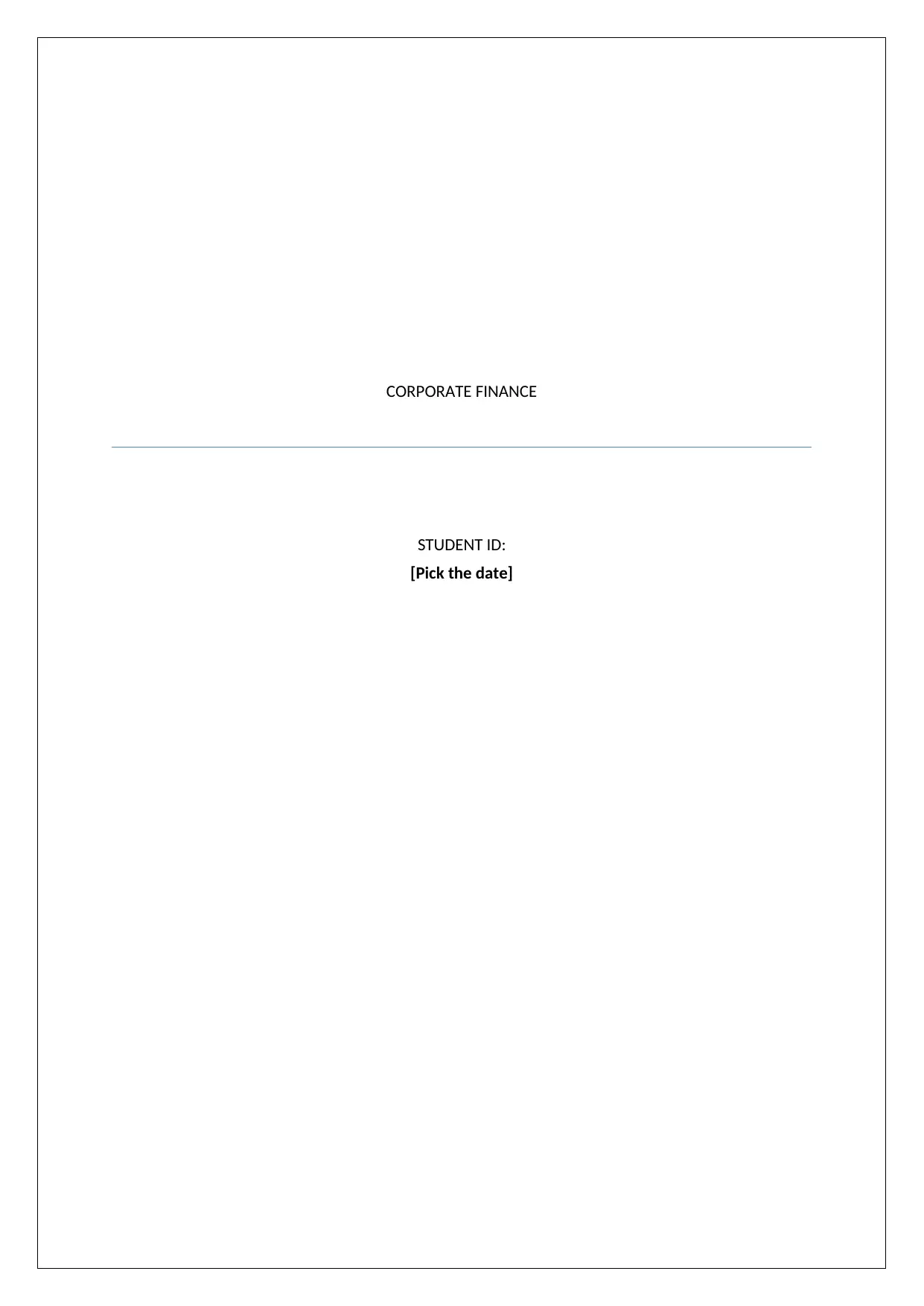
CORPORATE FINANCE
STUDENT ID:
[Pick the date]
STUDENT ID:
[Pick the date]
Paraphrase This Document
Need a fresh take? Get an instant paraphrase of this document with our AI Paraphraser
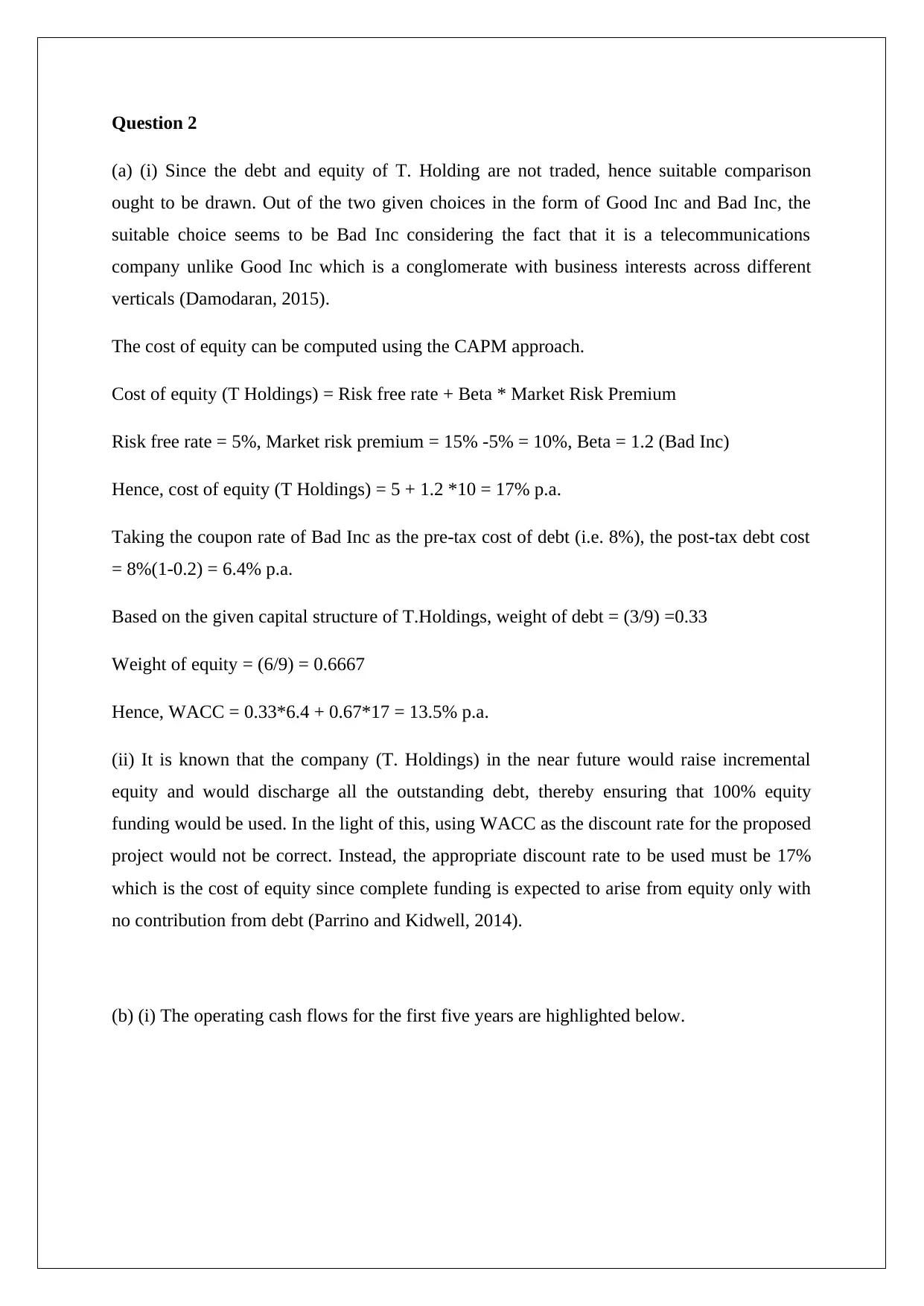
Question 2
(a) (i) Since the debt and equity of T. Holding are not traded, hence suitable comparison
ought to be drawn. Out of the two given choices in the form of Good Inc and Bad Inc, the
suitable choice seems to be Bad Inc considering the fact that it is a telecommunications
company unlike Good Inc which is a conglomerate with business interests across different
verticals (Damodaran, 2015).
The cost of equity can be computed using the CAPM approach.
Cost of equity (T Holdings) = Risk free rate + Beta * Market Risk Premium
Risk free rate = 5%, Market risk premium = 15% -5% = 10%, Beta = 1.2 (Bad Inc)
Hence, cost of equity (T Holdings) = 5 + 1.2 *10 = 17% p.a.
Taking the coupon rate of Bad Inc as the pre-tax cost of debt (i.e. 8%), the post-tax debt cost
= 8%(1-0.2) = 6.4% p.a.
Based on the given capital structure of T.Holdings, weight of debt = (3/9) =0.33
Weight of equity = (6/9) = 0.6667
Hence, WACC = 0.33*6.4 + 0.67*17 = 13.5% p.a.
(ii) It is known that the company (T. Holdings) in the near future would raise incremental
equity and would discharge all the outstanding debt, thereby ensuring that 100% equity
funding would be used. In the light of this, using WACC as the discount rate for the proposed
project would not be correct. Instead, the appropriate discount rate to be used must be 17%
which is the cost of equity since complete funding is expected to arise from equity only with
no contribution from debt (Parrino and Kidwell, 2014).
(b) (i) The operating cash flows for the first five years are highlighted below.
(a) (i) Since the debt and equity of T. Holding are not traded, hence suitable comparison
ought to be drawn. Out of the two given choices in the form of Good Inc and Bad Inc, the
suitable choice seems to be Bad Inc considering the fact that it is a telecommunications
company unlike Good Inc which is a conglomerate with business interests across different
verticals (Damodaran, 2015).
The cost of equity can be computed using the CAPM approach.
Cost of equity (T Holdings) = Risk free rate + Beta * Market Risk Premium
Risk free rate = 5%, Market risk premium = 15% -5% = 10%, Beta = 1.2 (Bad Inc)
Hence, cost of equity (T Holdings) = 5 + 1.2 *10 = 17% p.a.
Taking the coupon rate of Bad Inc as the pre-tax cost of debt (i.e. 8%), the post-tax debt cost
= 8%(1-0.2) = 6.4% p.a.
Based on the given capital structure of T.Holdings, weight of debt = (3/9) =0.33
Weight of equity = (6/9) = 0.6667
Hence, WACC = 0.33*6.4 + 0.67*17 = 13.5% p.a.
(ii) It is known that the company (T. Holdings) in the near future would raise incremental
equity and would discharge all the outstanding debt, thereby ensuring that 100% equity
funding would be used. In the light of this, using WACC as the discount rate for the proposed
project would not be correct. Instead, the appropriate discount rate to be used must be 17%
which is the cost of equity since complete funding is expected to arise from equity only with
no contribution from debt (Parrino and Kidwell, 2014).
(b) (i) The operating cash flows for the first five years are highlighted below.
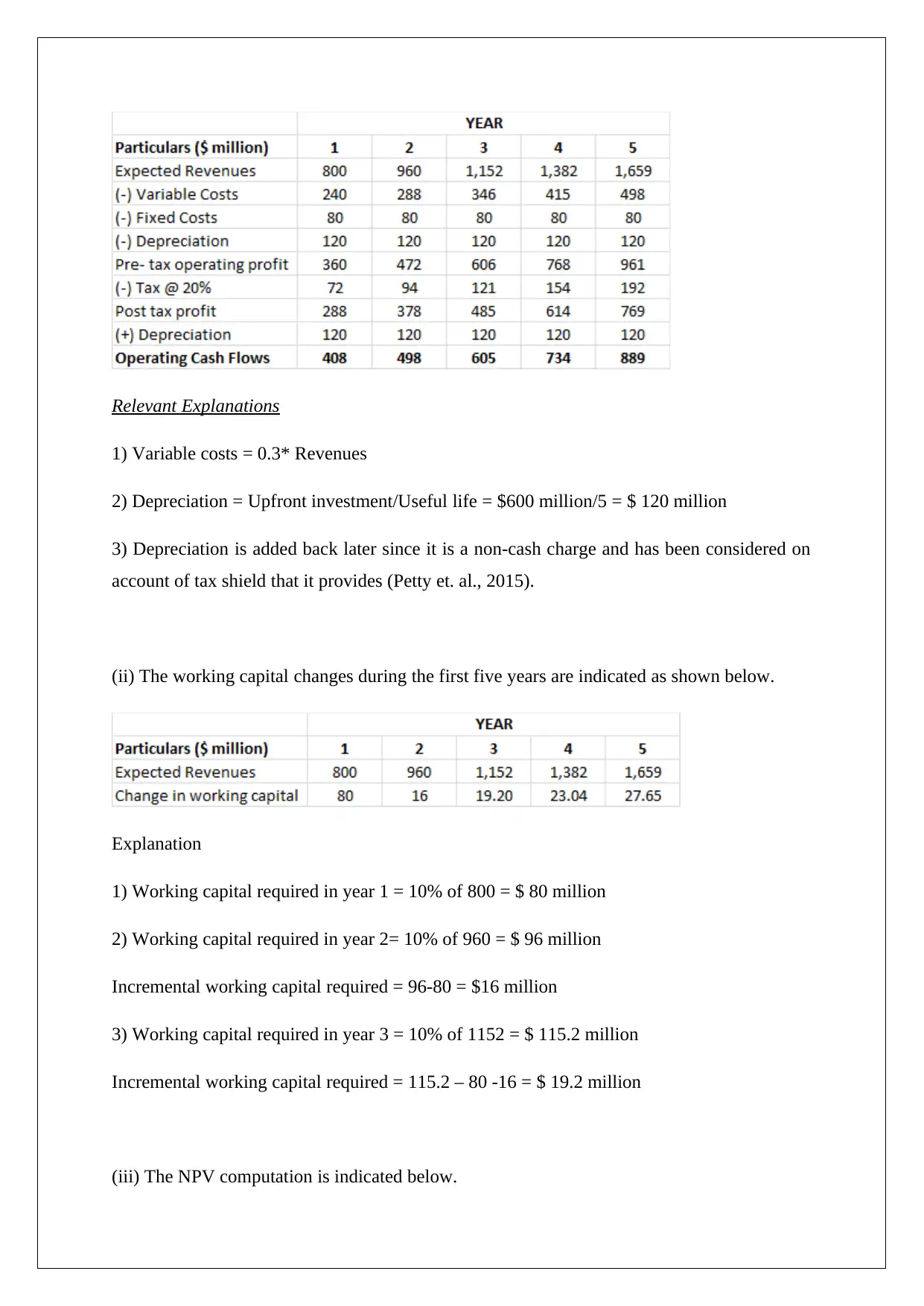
Relevant Explanations
1) Variable costs = 0.3* Revenues
2) Depreciation = Upfront investment/Useful life = $600 million/5 = $ 120 million
3) Depreciation is added back later since it is a non-cash charge and has been considered on
account of tax shield that it provides (Petty et. al., 2015).
(ii) The working capital changes during the first five years are indicated as shown below.
Explanation
1) Working capital required in year 1 = 10% of 800 = $ 80 million
2) Working capital required in year 2= 10% of 960 = $ 96 million
Incremental working capital required = 96-80 = $16 million
3) Working capital required in year 3 = 10% of 1152 = $ 115.2 million
Incremental working capital required = 115.2 – 80 -16 = $ 19.2 million
(iii) The NPV computation is indicated below.
1) Variable costs = 0.3* Revenues
2) Depreciation = Upfront investment/Useful life = $600 million/5 = $ 120 million
3) Depreciation is added back later since it is a non-cash charge and has been considered on
account of tax shield that it provides (Petty et. al., 2015).
(ii) The working capital changes during the first five years are indicated as shown below.
Explanation
1) Working capital required in year 1 = 10% of 800 = $ 80 million
2) Working capital required in year 2= 10% of 960 = $ 96 million
Incremental working capital required = 96-80 = $16 million
3) Working capital required in year 3 = 10% of 1152 = $ 115.2 million
Incremental working capital required = 115.2 – 80 -16 = $ 19.2 million
(iii) The NPV computation is indicated below.
⊘ This is a preview!⊘
Do you want full access?
Subscribe today to unlock all pages.

Trusted by 1+ million students worldwide
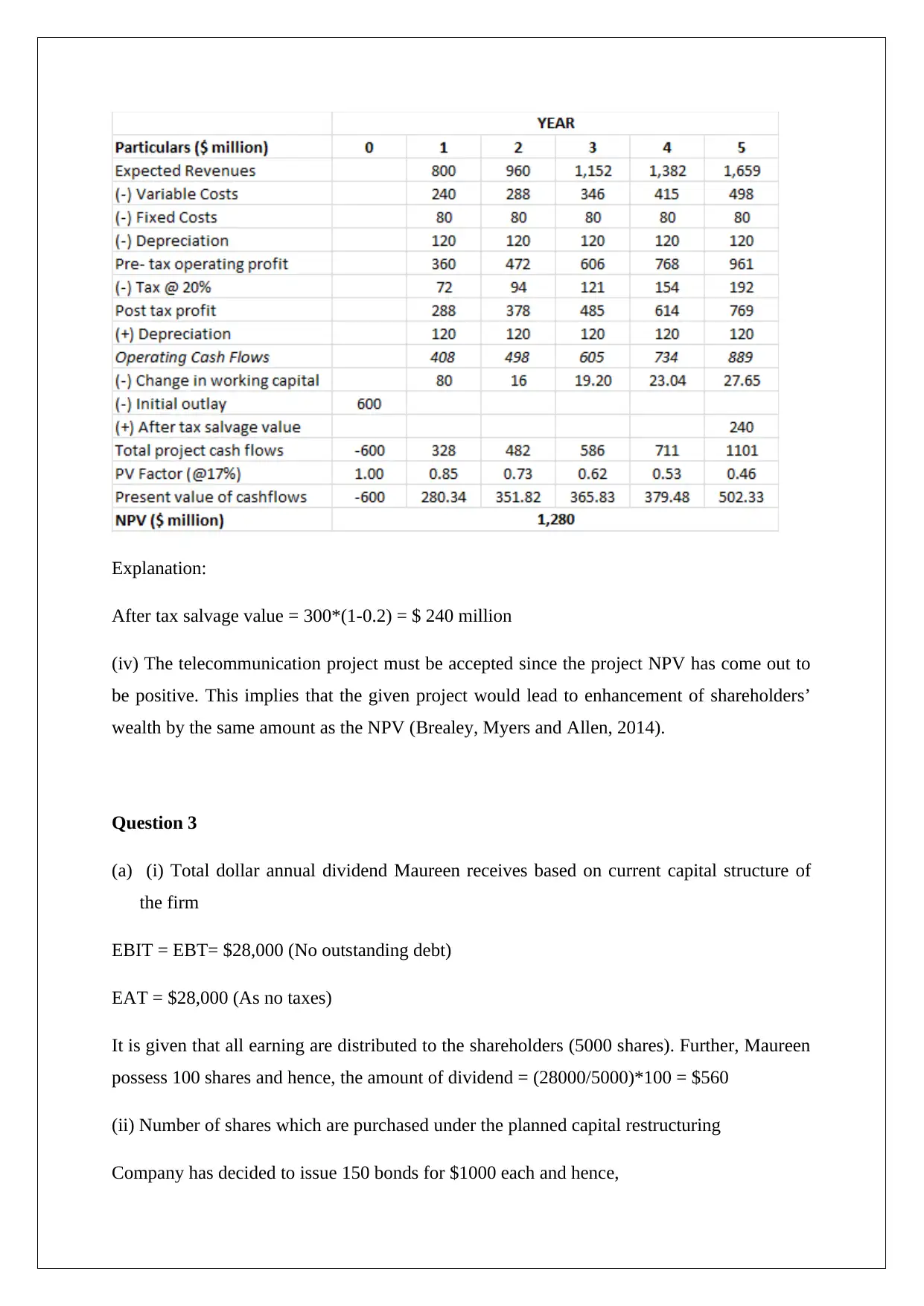
Explanation:
After tax salvage value = 300*(1-0.2) = $ 240 million
(iv) The telecommunication project must be accepted since the project NPV has come out to
be positive. This implies that the given project would lead to enhancement of shareholders’
wealth by the same amount as the NPV (Brealey, Myers and Allen, 2014).
Question 3
(a) (i) Total dollar annual dividend Maureen receives based on current capital structure of
the firm
EBIT = EBT= $28,000 (No outstanding debt)
EAT = $28,000 (As no taxes)
It is given that all earning are distributed to the shareholders (5000 shares). Further, Maureen
possess 100 shares and hence, the amount of dividend = (28000/5000)*100 = $560
(ii) Number of shares which are purchased under the planned capital restructuring
Company has decided to issue 150 bonds for $1000 each and hence,
After tax salvage value = 300*(1-0.2) = $ 240 million
(iv) The telecommunication project must be accepted since the project NPV has come out to
be positive. This implies that the given project would lead to enhancement of shareholders’
wealth by the same amount as the NPV (Brealey, Myers and Allen, 2014).
Question 3
(a) (i) Total dollar annual dividend Maureen receives based on current capital structure of
the firm
EBIT = EBT= $28,000 (No outstanding debt)
EAT = $28,000 (As no taxes)
It is given that all earning are distributed to the shareholders (5000 shares). Further, Maureen
possess 100 shares and hence, the amount of dividend = (28000/5000)*100 = $560
(ii) Number of shares which are purchased under the planned capital restructuring
Company has decided to issue 150 bonds for $1000 each and hence,
Paraphrase This Document
Need a fresh take? Get an instant paraphrase of this document with our AI Paraphraser
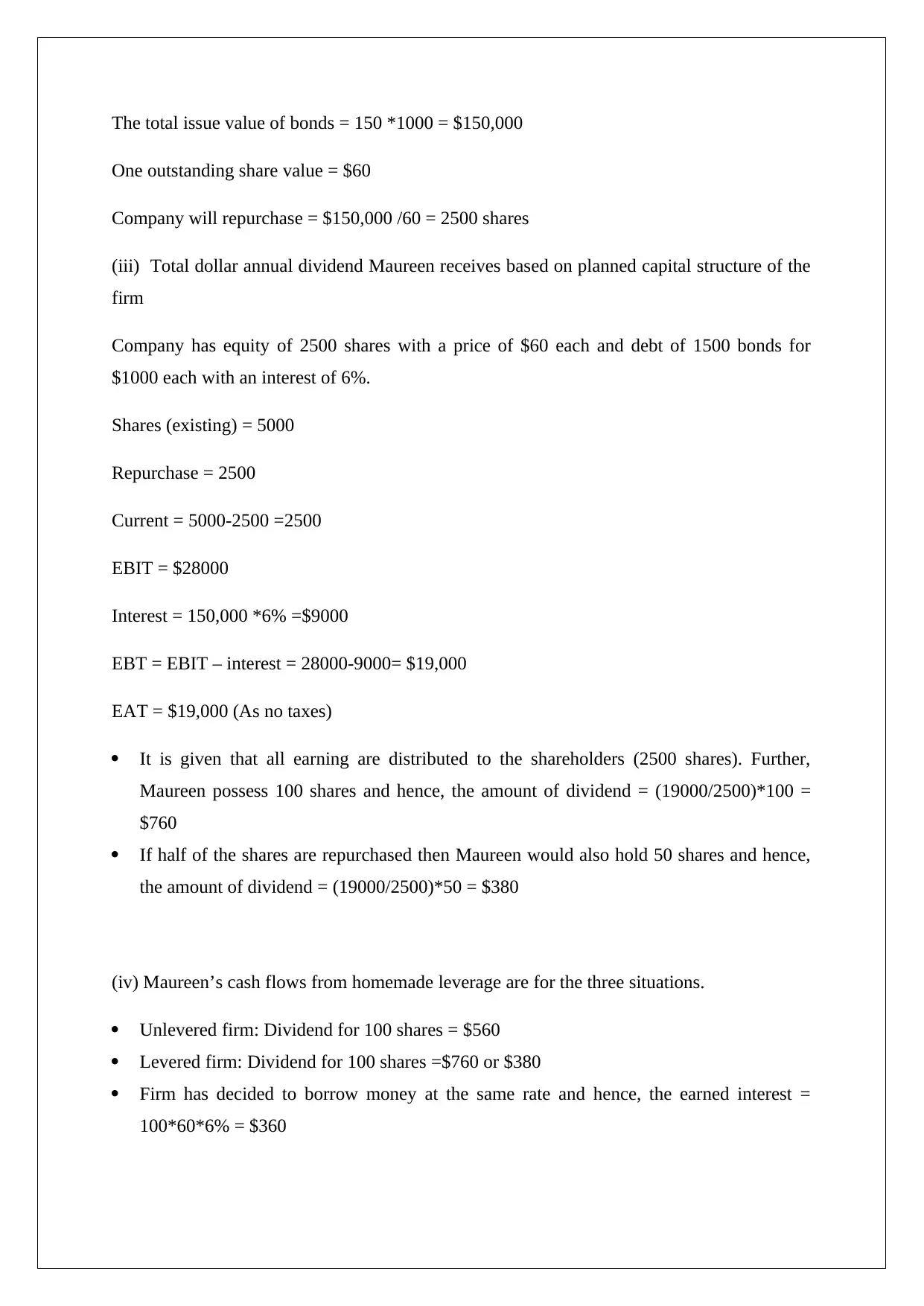
The total issue value of bonds = 150 *1000 = $150,000
One outstanding share value = $60
Company will repurchase = $150,000 /60 = 2500 shares
(iii) Total dollar annual dividend Maureen receives based on planned capital structure of the
firm
Company has equity of 2500 shares with a price of $60 each and debt of 1500 bonds for
$1000 each with an interest of 6%.
Shares (existing) = 5000
Repurchase = 2500
Current = 5000-2500 =2500
EBIT = $28000
Interest = 150,000 *6% =$9000
EBT = EBIT – interest = 28000-9000= $19,000
EAT = $19,000 (As no taxes)
It is given that all earning are distributed to the shareholders (2500 shares). Further,
Maureen possess 100 shares and hence, the amount of dividend = (19000/2500)*100 =
$760
If half of the shares are repurchased then Maureen would also hold 50 shares and hence,
the amount of dividend = (19000/2500)*50 = $380
(iv) Maureen’s cash flows from homemade leverage are for the three situations.
Unlevered firm: Dividend for 100 shares = $560
Levered firm: Dividend for 100 shares =$760 or $380
Firm has decided to borrow money at the same rate and hence, the earned interest =
100*60*6% = $360
One outstanding share value = $60
Company will repurchase = $150,000 /60 = 2500 shares
(iii) Total dollar annual dividend Maureen receives based on planned capital structure of the
firm
Company has equity of 2500 shares with a price of $60 each and debt of 1500 bonds for
$1000 each with an interest of 6%.
Shares (existing) = 5000
Repurchase = 2500
Current = 5000-2500 =2500
EBIT = $28000
Interest = 150,000 *6% =$9000
EBT = EBIT – interest = 28000-9000= $19,000
EAT = $19,000 (As no taxes)
It is given that all earning are distributed to the shareholders (2500 shares). Further,
Maureen possess 100 shares and hence, the amount of dividend = (19000/2500)*100 =
$760
If half of the shares are repurchased then Maureen would also hold 50 shares and hence,
the amount of dividend = (19000/2500)*50 = $380
(iv) Maureen’s cash flows from homemade leverage are for the three situations.
Unlevered firm: Dividend for 100 shares = $560
Levered firm: Dividend for 100 shares =$760 or $380
Firm has decided to borrow money at the same rate and hence, the earned interest =
100*60*6% = $360
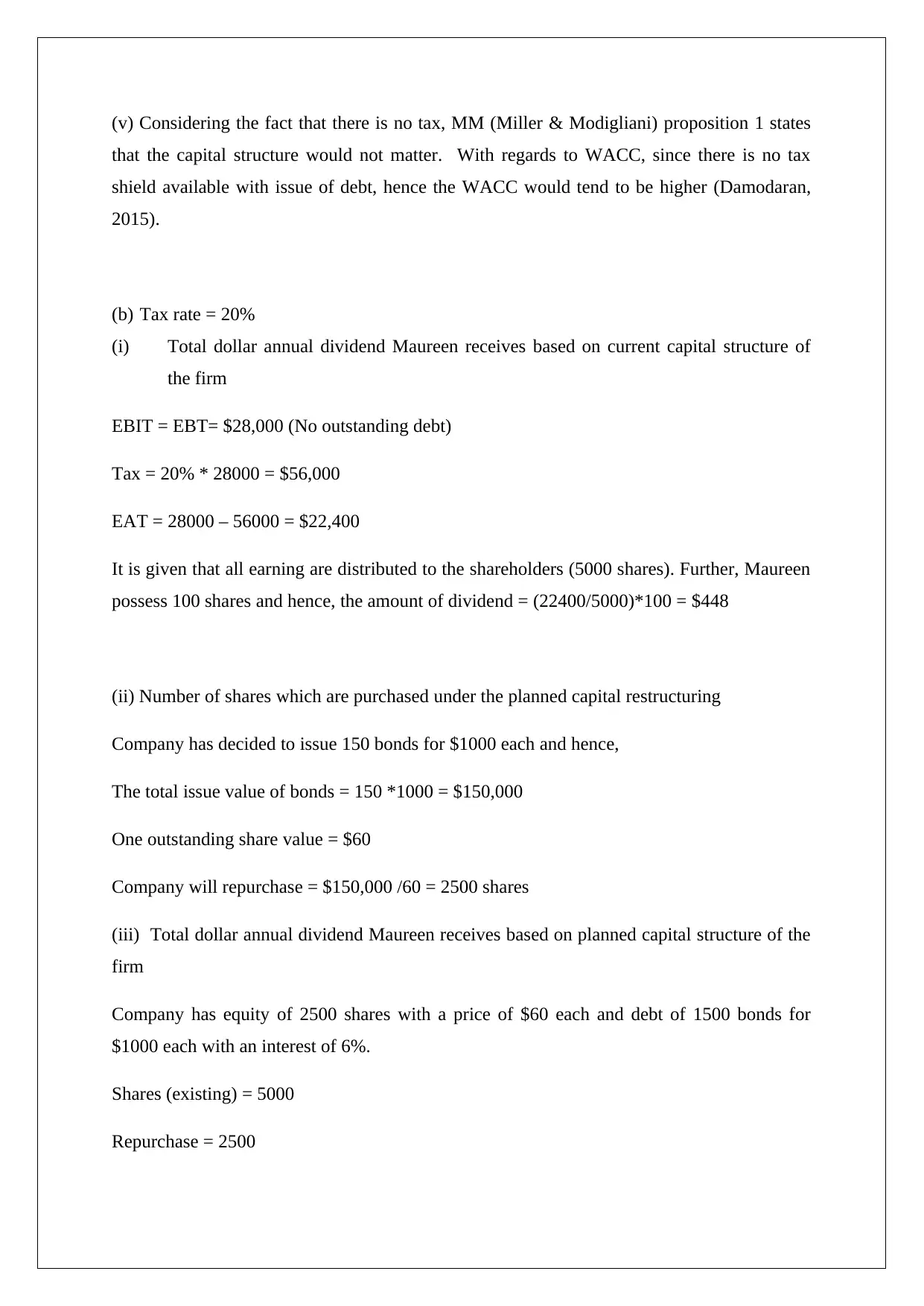
(v) Considering the fact that there is no tax, MM (Miller & Modigliani) proposition 1 states
that the capital structure would not matter. With regards to WACC, since there is no tax
shield available with issue of debt, hence the WACC would tend to be higher (Damodaran,
2015).
(b) Tax rate = 20%
(i) Total dollar annual dividend Maureen receives based on current capital structure of
the firm
EBIT = EBT= $28,000 (No outstanding debt)
Tax = 20% * 28000 = $56,000
EAT = 28000 – 56000 = $22,400
It is given that all earning are distributed to the shareholders (5000 shares). Further, Maureen
possess 100 shares and hence, the amount of dividend = (22400/5000)*100 = $448
(ii) Number of shares which are purchased under the planned capital restructuring
Company has decided to issue 150 bonds for $1000 each and hence,
The total issue value of bonds = 150 *1000 = $150,000
One outstanding share value = $60
Company will repurchase = $150,000 /60 = 2500 shares
(iii) Total dollar annual dividend Maureen receives based on planned capital structure of the
firm
Company has equity of 2500 shares with a price of $60 each and debt of 1500 bonds for
$1000 each with an interest of 6%.
Shares (existing) = 5000
Repurchase = 2500
that the capital structure would not matter. With regards to WACC, since there is no tax
shield available with issue of debt, hence the WACC would tend to be higher (Damodaran,
2015).
(b) Tax rate = 20%
(i) Total dollar annual dividend Maureen receives based on current capital structure of
the firm
EBIT = EBT= $28,000 (No outstanding debt)
Tax = 20% * 28000 = $56,000
EAT = 28000 – 56000 = $22,400
It is given that all earning are distributed to the shareholders (5000 shares). Further, Maureen
possess 100 shares and hence, the amount of dividend = (22400/5000)*100 = $448
(ii) Number of shares which are purchased under the planned capital restructuring
Company has decided to issue 150 bonds for $1000 each and hence,
The total issue value of bonds = 150 *1000 = $150,000
One outstanding share value = $60
Company will repurchase = $150,000 /60 = 2500 shares
(iii) Total dollar annual dividend Maureen receives based on planned capital structure of the
firm
Company has equity of 2500 shares with a price of $60 each and debt of 1500 bonds for
$1000 each with an interest of 6%.
Shares (existing) = 5000
Repurchase = 2500
⊘ This is a preview!⊘
Do you want full access?
Subscribe today to unlock all pages.

Trusted by 1+ million students worldwide
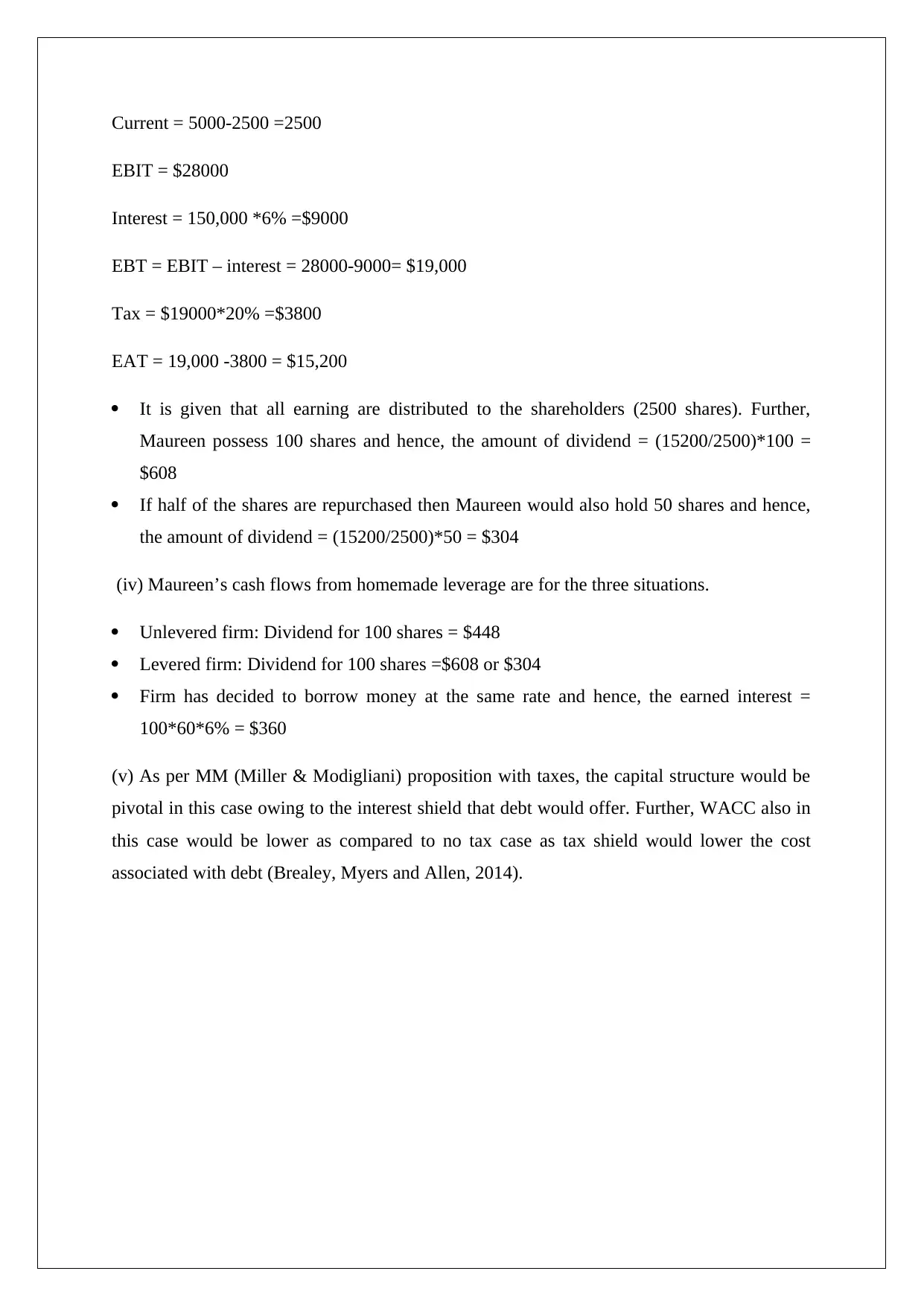
Current = 5000-2500 =2500
EBIT = $28000
Interest = 150,000 *6% =$9000
EBT = EBIT – interest = 28000-9000= $19,000
Tax = $19000*20% =$3800
EAT = 19,000 -3800 = $15,200
It is given that all earning are distributed to the shareholders (2500 shares). Further,
Maureen possess 100 shares and hence, the amount of dividend = (15200/2500)*100 =
$608
If half of the shares are repurchased then Maureen would also hold 50 shares and hence,
the amount of dividend = (15200/2500)*50 = $304
(iv) Maureen’s cash flows from homemade leverage are for the three situations.
Unlevered firm: Dividend for 100 shares = $448
Levered firm: Dividend for 100 shares =$608 or $304
Firm has decided to borrow money at the same rate and hence, the earned interest =
100*60*6% = $360
(v) As per MM (Miller & Modigliani) proposition with taxes, the capital structure would be
pivotal in this case owing to the interest shield that debt would offer. Further, WACC also in
this case would be lower as compared to no tax case as tax shield would lower the cost
associated with debt (Brealey, Myers and Allen, 2014).
EBIT = $28000
Interest = 150,000 *6% =$9000
EBT = EBIT – interest = 28000-9000= $19,000
Tax = $19000*20% =$3800
EAT = 19,000 -3800 = $15,200
It is given that all earning are distributed to the shareholders (2500 shares). Further,
Maureen possess 100 shares and hence, the amount of dividend = (15200/2500)*100 =
$608
If half of the shares are repurchased then Maureen would also hold 50 shares and hence,
the amount of dividend = (15200/2500)*50 = $304
(iv) Maureen’s cash flows from homemade leverage are for the three situations.
Unlevered firm: Dividend for 100 shares = $448
Levered firm: Dividend for 100 shares =$608 or $304
Firm has decided to borrow money at the same rate and hence, the earned interest =
100*60*6% = $360
(v) As per MM (Miller & Modigliani) proposition with taxes, the capital structure would be
pivotal in this case owing to the interest shield that debt would offer. Further, WACC also in
this case would be lower as compared to no tax case as tax shield would lower the cost
associated with debt (Brealey, Myers and Allen, 2014).
Paraphrase This Document
Need a fresh take? Get an instant paraphrase of this document with our AI Paraphraser
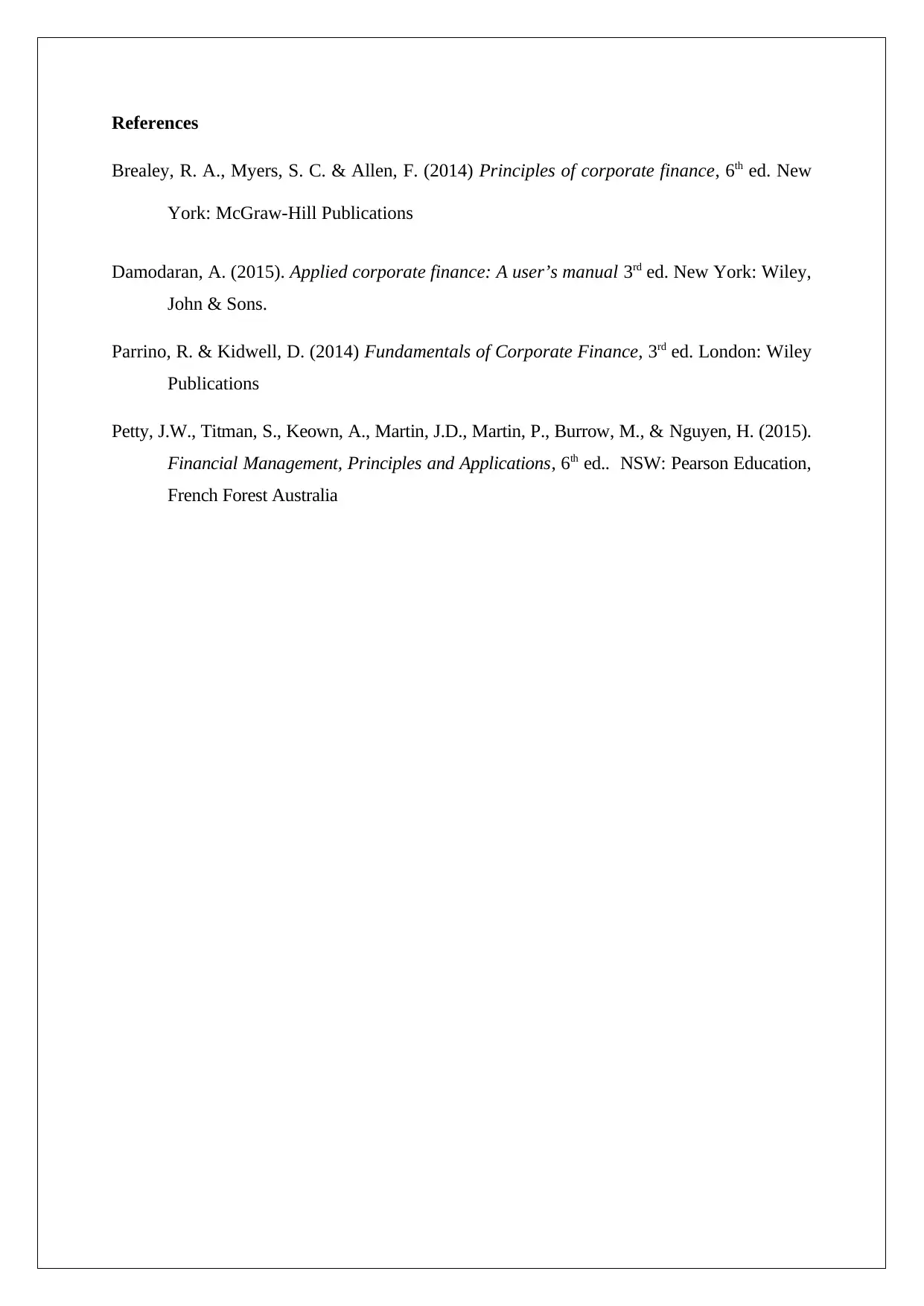
References
Brealey, R. A., Myers, S. C. & Allen, F. (2014) Principles of corporate finance, 6th ed. New
York: McGraw-Hill Publications
Damodaran, A. (2015). Applied corporate finance: A user’s manual 3rd ed. New York: Wiley,
John & Sons.
Parrino, R. & Kidwell, D. (2014) Fundamentals of Corporate Finance, 3rd ed. London: Wiley
Publications
Petty, J.W., Titman, S., Keown, A., Martin, J.D., Martin, P., Burrow, M., & Nguyen, H. (2015).
Financial Management, Principles and Applications, 6th ed.. NSW: Pearson Education,
French Forest Australia
Brealey, R. A., Myers, S. C. & Allen, F. (2014) Principles of corporate finance, 6th ed. New
York: McGraw-Hill Publications
Damodaran, A. (2015). Applied corporate finance: A user’s manual 3rd ed. New York: Wiley,
John & Sons.
Parrino, R. & Kidwell, D. (2014) Fundamentals of Corporate Finance, 3rd ed. London: Wiley
Publications
Petty, J.W., Titman, S., Keown, A., Martin, J.D., Martin, P., Burrow, M., & Nguyen, H. (2015).
Financial Management, Principles and Applications, 6th ed.. NSW: Pearson Education,
French Forest Australia
1 out of 8
Related Documents
Your All-in-One AI-Powered Toolkit for Academic Success.
+13062052269
info@desklib.com
Available 24*7 on WhatsApp / Email
![[object Object]](/_next/static/media/star-bottom.7253800d.svg)
Unlock your academic potential
Copyright © 2020–2025 A2Z Services. All Rights Reserved. Developed and managed by ZUCOL.



